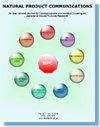羟基酪醇可改善小鼠模型中丁胺磺酸诱发的少精子症
IF 1.4
4区 医学
Q4 CHEMISTRY, MEDICINAL
引用次数: 0
摘要
目的羟基酪醇(HT)是在橄榄油和橄榄叶中发现的一种多酚成分,因其具有多种有益的生物特性而成为研究最广泛的天然酚之一。最近的研究表明,羟基酪醇对生殖功能有保护作用,并能提高精子质量。然而,HT 对少精症的确切影响和内在机制仍不清楚。本研究旨在探讨不同浓度的 HT 对少精子症的影响和机制。小鼠随机分为五组,分别为正常组、BUS组、HT 10 mg/kg组、HT 30 mg/kg组和HT 50 mg/kg组。使用计算机辅助精子分析系统,通过精子浓度和活力评估HT对少精症的疗效。睾丸和附睾组织学检查采用苏木精-伊红染色法,细胞骨架完整性则采用免疫荧光法进行评估。激素水平以及活性氧(ROS)和丙二醛(MDA)通过酶联免疫吸附试剂盒进行检测。结果表明,HT(50 毫克/千克)能显著提高少精症小鼠的精子浓度,促进睾丸组织的形态学恢复,提高血清睾酮、卵泡刺激素和黄体生成素的水平,减少 ROS 和 MDA 的积累。RNA测序分析和RT-qPCR结果显示,HT可通过上调纤毛组织、微管运动、精子分化和发育相关基因,恢复精子发生,改善少精症。HT对少精症的作用机制可能与它对纤毛和微管运动以及精子分化和发育的影响有关。HT有望成为治疗少精症的一种前瞻性治疗干预手段。本文章由计算机程序翻译,如有差异,请以英文原文为准。
Hydroxytyrosol Ameliorates Busulfan-Induced Oligozoospermia in a Mouse Model
ObjectiveHydroxytyrosol (HT), a polyphenolic component identified in olive oil and leaves, represents one of the most extensively investigated natural phenol due to its diverse beneficial biological properties. Recent studies have shown that HT exhibits protective effects on reproductive function and can improve sperm quality. However, the precise effect and underlying mechanism of HT on oligozoospermia remain unclear. This study aims to investigate the effect and mechanism of HT across varying concentrations on oligozoospermia.MethodsOligozoospermia was induced in ICR male mice via intraperitoneal injection of busulfan (BUS, 30 mg/kg). The mice were randomly categorized into five groups as Normal, BUS, HT 10 mg/kg, HT 30 mg/kg and HT 50 mg/kg. The efficacy of HT on oligozoospermia was assessed through sperm concentration and motility using a computer-assisted sperm analysis system. Testicular and epididymal histology was examined via hematoxylin-eosin staining, while cytoskeletal integrity was evaluated by immunofluorescence. Hormone levels, along with reactive oxygen species (ROS) and malondialdehyde (MDA) were examined by ELISA kits. Differentially expressed genes were identified through RNA sequencing, and the expression levels of key genes were validated by qPCR.ResultsThe results indicated that HT (50 mg/kg) significantly increased sperm concentration, promoted morphological recovery of testicular tissue, heightened the levels of serum testosterone, follicle-stimulating hormone, luteinizing hormone, as well as decreased the accumulation of ROS and MDA in mice with oligozoospermia. RNA sequencing analysis and RT-qPCR results revealed that HT could restore spermatogenesis and ameliorate oligozoospermia by up-regulating genes related to cilium organization, microtubule-based movement, and spermatid differentiation and development.ConclusionsHT demonstrates therapeutic efficacy against busulfan-induced oligozoospermia. The mechanism of HT on oligozoospermia may be related to its influence on cilium and microtubule-based movement, along with the differentiation and development of spermatids. HT shows potential as a prospective therapeutic intervention for the treatment of oligozoospermia.
求助全文
通过发布文献求助,成功后即可免费获取论文全文。
去求助
来源期刊

Natural Product Communications
工程技术-食品科技
CiteScore
3.10
自引率
11.10%
发文量
254
审稿时长
2.7 months
期刊介绍:
Natural Product Communications is a peer reviewed, open access journal studying all aspects of natural products, including isolation, characterization, spectroscopic properties, biological activities, synthesis, structure-activity, biotransformation, biosynthesis, tissue culture and fermentation. It covers the full breadth of chemistry, biochemistry, biotechnology, pharmacology, and chemical ecology of natural products.
Natural Product Communications is a peer reviewed, open access journal studying all aspects of natural products, including isolation, characterization, spectroscopic properties, biological activities, synthesis, structure-activity, biotransformation, biosynthesis, tissue culture and fermentation. It covers the full breadth of chemistry, biochemistry, biotechnology, pharmacology, and chemical ecology of natural products.
Natural Product Communications is a peer reviewed, open access journal studying all aspects of natural products, including isolation, characterization, spectroscopic properties, biological activities, synthesis, structure-activity, biotransformation, biosynthesis, tissue culture and fermentation. It covers the full breadth of chemistry, biochemistry, biotechnology, pharmacology, and chemical ecology of natural products.
 求助内容:
求助内容: 应助结果提醒方式:
应助结果提醒方式:


